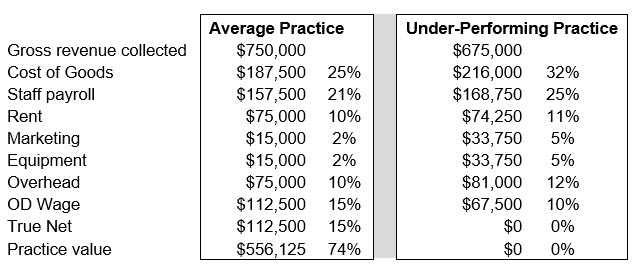By Mark Wright, OD, FCOVD,![]()
and Carole Burns, OD, FCOVD
Sept. 29, 2021
How much is your practice worth today? What number can you look at to determine if you are at a healthy number or not? There is one important number to consider when thinking about a practice. That number is the practice True Net.
In today’s world, the practice True Net drives the practice value. Here is how to calculate True Net, so you know how much your practice is really worth today, and what you need to do to increase its value.
The practice net is an interesting number in optometry. Traditionally, we were taught to calculate the practice net to be what you are paying for all ODs working in the practice (including the owner) plus anything left over after paying all other expenses. No other business does this. Our best guess is that most OD practices in the beginning of our profession were one-doctor practices. A bad habit started back then with the owner-doctor first paying all expenses, then calling what was left over – including their own wage – the net. Under this system, an average net was 30 percent of gross revenue collected.
Modern practices do not think this way. Modern businesses pay all expenses including the doctor(s) working in the practice (the average is 15 percent of gross revenue collected, the maximum is 20 percent of gross revenue collected), then consider what is left over as the True Net (generally 15 percent of gross revenue collected, with some practices generating 25 percent or more of gross revenue collected).
With that background, let’s examine what would we expect from an average performing practice and what we see from under-performing practices. Specifically, we want to focus on what happens to the practice True Net and the Practice Value.

Notice that the individual line percentage differences for expenses are not that far apart, however, the total impact on the practice True Net and the Practice Value are devastating in the Under-Performing Practice. There is not enough money in the Under-Performing Practice to allow a bank to fund a purchase of the practice because there is no money in the True Net available to pay the banker back.
Notice also that the OD in the Under-Performing Practice is being paid less than the average OD wage of 15 percent of gross revenue collected. Let’s look closer at the total income of what these two doctors are being paid. If the owner is the OD working in the Average Practice, the owner’s total income is the OD Wage plus the True Net ($112,500 + $112,500), which is $225,000. If the owner is the OD working in the Under-Performing Practice, then the owner’s total income is only $67,000. That difference definitely impacts the OD owner’s ability to positively manage their personal wealth building and that directly impacts quality of life decisions.
Other Articles to Explore
Sometimes, practice owners purposefully drive the practice net down in an attempt to reduce their tax burden. This strategy may have the desired impact on tax exposure, however, minimizing your practice tax exposure by creating a lower net also drives down practice value.
To get the most money for your practice sale, make sure that you are maximizing your True Net for at least three years before the sale. That approach gives you the highest practice value when it comes time to sell your practice. And if you have been maximizing your practice True Net over time, then you are also giving yourself the best opportunity to build personal wealth.
Now, all you need is a plan. Take this week to review (or make) your plans for:
1) Maximizing your practice’s True Net
2) Personal wealth building



























